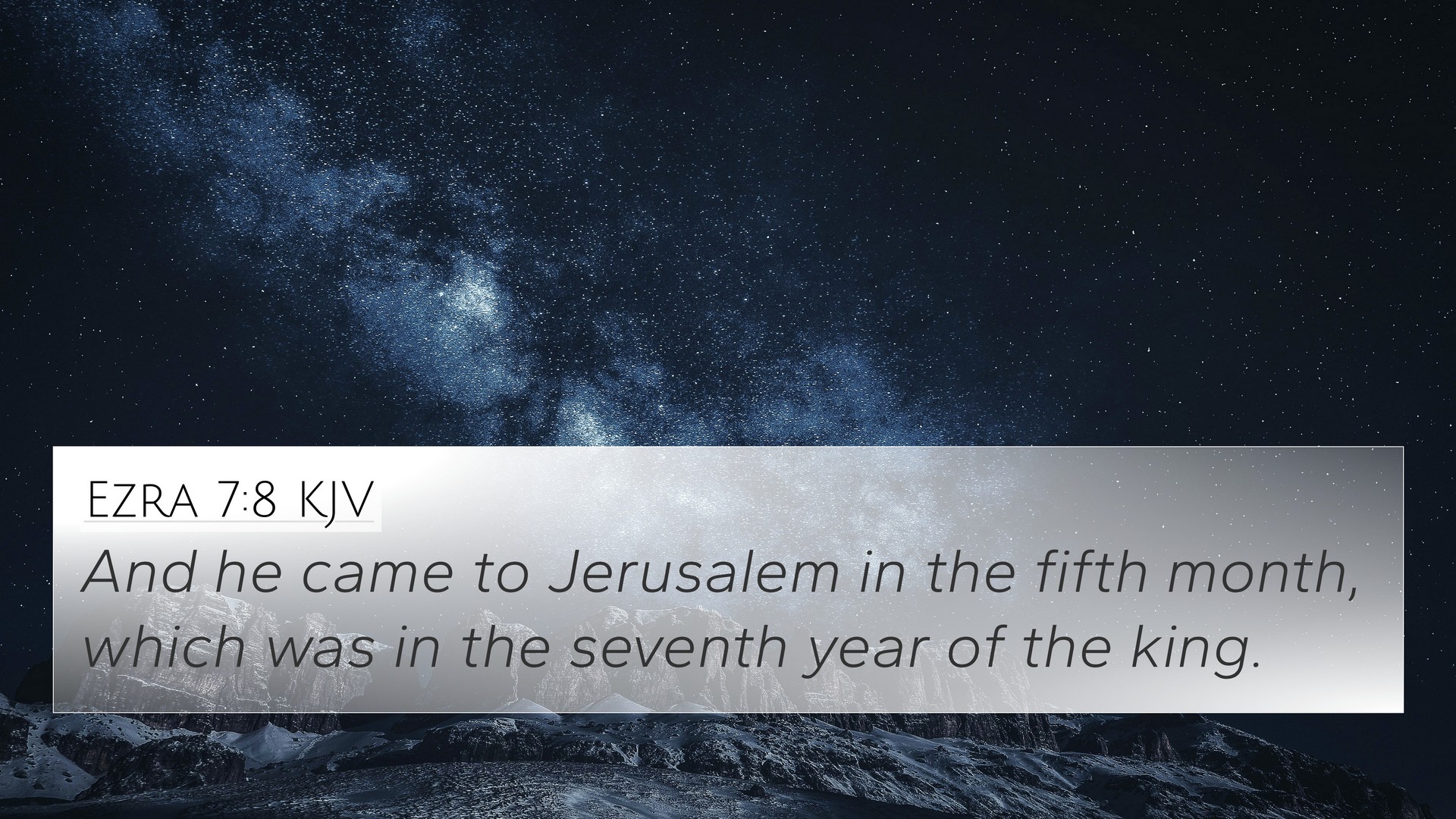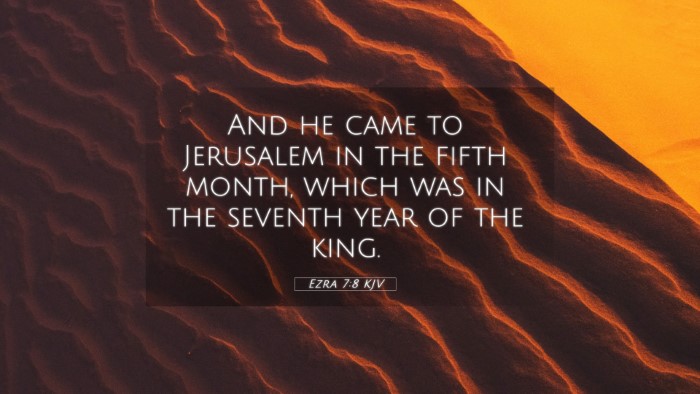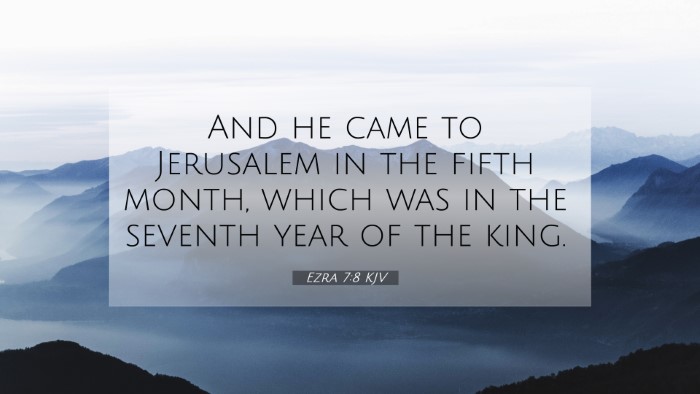Old Testament
Genesis Exodus Leviticus Numbers Deuteronomy Joshua Judges Ruth 1 Samuel 2 Samuel 1 Kings 2 Kings 1 Chronicles 2 Chronicles Ezra Nehemiah Esther Job Psalms Proverbs Ecclesiastes Song of Solomon Isaiah Jeremiah Lamentations Ezekiel Daniel Hosea Joel Amos Obadiah Jonah Micah Nahum Habakkuk Zephaniah Haggai Zechariah MalachiEzra 7:8 Similar Verses
Ezra 7:8 Cross References
And he came to Jerusalem in the fifth month, which was in the seventh year of the king.
Uncover the Rich Themes and Topics of This Bible Verse
Listed below are the Bible themes associated with Ezra 7:8. We invite you to explore each theme to gain deeper insights into the Scriptures.
Ezra 7:8 Cross Reference Verses
No cross reference images were found in our system for this Bible passage.
Ezra 7:8 Verse Analysis and Similar Verses
Understanding Ezra 7:8
Ezra 7:8 reads:
"And he came to Jerusalem in the fifth month, which was in the seventh year of the king."
Verse Summary
This verse marks a significant moment in the history of the Jewish people following their return from Babylonian exile. Ezra led a group of exiles back to Jerusalem, indicating the beginning of a crucial period of restoration and reform.
Commentary Insights
Matthew Henry's Commentary
Matthew Henry emphasizes the importance of Ezra’s journey to Jerusalem as an act of devotion and commitment to restore the law of God among His people. He discusses how Ezra prepared himself through study and practice of the law, suggesting that spiritual leaders must embody the teachings they espouse.
Albert Barnes' Notes
Albert Barnes highlights the timing of Ezra's arrival, noting that it was specifically in the fifth month, which parallels significant religious events. His analysis suggests a divine orchestration of successes as Ezra came to instruct the people, reinforcing the notion of God’s providence in restoring His covenant community.
Adam Clarke's Commentary
Adam Clarke discusses Ezra's family lineage and how it set the stage for him to be a leader among the exiles. He delves into the geographical aspects of Ezra's journey, interpreting it in relation to the spiritual journey of returning to the place of worship and covenant.
Bible Verse Cross-References
- Ezra 1:1-3: The call to return to Jerusalem initiated by King Cyrus.
- Ezra 3:1: The gathering of the people to Jerusalem to restore worship.
- Nehemiah 8:1-3: The reading of the Law upon Ezra’s arrival.
- Jeremiah 29:10: Prophecy of the return from exile after 70 years.
- Isaiah 44:28: Cyrus appointed God’s anointed for the rebuilding of Jerusalem.
- Psalms 126:1-3: Joy in returning to Zion from captivity.
- Malachi 2:7: The role of priests in guarding knowledge and providing instruction.
- Hebrews 10:25: The importance of assembling together in worship.
- Acts 15:21: The reading of the Law in synagogues as a foundation for community life.
- Matthew 5:17-19: Jesus’ teaching on the Law and the Prophets, reflecting the continuity of God’s commandments.
Thematic Connections
This verse serves as a key intersection for thematic elements throughout Scripture:
- Restoration: Ezra’s arrival symbolizes the restoration of worship and adherence to God’s Law, a theme echoed in the writings of the prophets and the New Testament.
- Leadership: The example of Ezra as a leader who prioritizes spiritual literacy and education aligns with New Testament teachings about shepherding God’s people.
- Divine Providence: The orchestrated timing of events in Scripture reinforces the belief that God directs the affairs of nations for the good of His people.
- Covenant Community: The gathering of the exiles under Ezra's leadership points to the importance of community in worship, a theme found throughout the New Testament.
Cross-Referencing Biblical Texts
The act of cross-referencing biblical texts, as demonstrated in the above analysis, enhances understanding by identifying connections and themes. Here are a few tools to aid in your biblical study:
- Bible Concordance: A powerful tool for locating verses and their cross-references.
- Bible Cross-Reference Guide: Helps in identifying fruitful connections between verses.
- Cross-Reference Bible Study: Methods for comparing thematic elements across Scripture.
- Bible Chain References: Systems that link passages related by themes or concepts.
- Bible Reference Resources: Tools and guides for deeper study and theological understanding.
Conclusion
In summary, Ezra 7:8 is rich with historical and spiritual significance. It offers a lens through which one can understand the restoration of God’s covenant people, the importance of spiritual leadership, and the overarching theme of divine providence that runs through both the Old and New Testaments. Engaging with this verse and its cross-references invites a deeper reflection on the nature of God’s relationship with His people and the enduring relevance of His Word.


